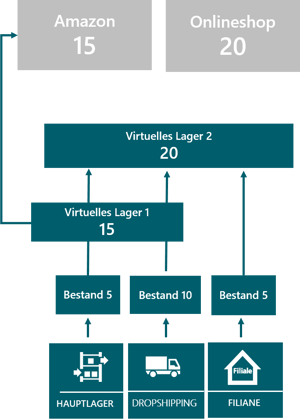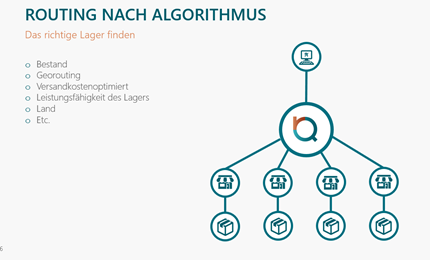Logistics: challenges and potential in omnichannel commerce
Today's customer expects a smooth shopping experience across all touchpoints. In omnichannel commerce, numerous extremely complex processes have to be mapped in the backend and controlled in such a way that the customer doesn't notice anything and ends up holding the goods in their hands with satisfaction. For example, it is essential that complex storage and logistics processes are managed centrally and that all relevant data is communicated to all touchpoints in real time if possible.
Make different types of warehouse in e-commerce shippable
Online shops and omnichannel retailers in particular sometimes have to keep large stocks in stock. Classically, these are found in a main camp. However, the goods can also be distributed to other warehouses. In addition to their own main warehouse, retailers can also use branches as warehouses or external logisticians. Via third-party suppliers (dropshippers), for example, one's own range can be expanded with relatively low investment costs. There is also the option of having goods delivered directly from the manufacturer to the end customer in your own name. These and other options can be implemented with a backend system such as the ROQQIO Commerce Cloud.
With such a system, every location with stocks can ultimately be made dispatchable, but not all warehouses are the same. In operational business, it makes a huge difference how the pick-and-pack process works in the various warehouses. While the orders in the main warehouse are usually route-optimized and possibly picked with rescue trucks and hundreds or thousands of packages leave the warehouse every day via dispatch routes, the sales staff in the branch look for the goods in the area and prepare them for dispatch at a small packing table. These different processes must be taken into account in the backend system, because some of them require additional system integration, such as that of warehouse management systems.
For the customer, this differentiation is irrelevant, he shouldn't even notice from which warehouse he is being served. In any case, communication must be uniform.
Create virtual warehouses and keep inventories up to date
In the case of decentralized warehouses, coordination and communication between the individual warehouses and the company-wide inventory management system is essential, because it must be clear at all times which goods are in which quantity and at which location. Otherwise, problems such as overselling will quickly arise. And that's extremely tricky - it means that a customer's request may not be fulfilled and the customer is left disappointed or annoyed. For merchants who sell on marketplaces, overselling is problematic for another reason: if the cancellation rate rises above a certain level, this can lead to a poorer ranking or even to the account being blocked. Amazon, for example, is very strict about this.
 In order to avoid such annoyances, it is crucial to keep the stocks in the different warehouses and on the sales channels up to date. This is achieved using "virtual warehouses" in which the physical stocks are accumulated. To put it simply, sales, reservations and safety stocks are deducted and the current value is communicated to the respective sales channels in almost real time.
In order to avoid such annoyances, it is crucial to keep the stocks in the different warehouses and on the sales channels up to date. This is achieved using "virtual warehouses" in which the physical stocks are accumulated. To put it simply, sales, reservations and safety stocks are deducted and the current value is communicated to the respective sales channels in almost real time.
The virtual warehouses are created, configured and managed in the ROQQIO Commerce Cloud. The inventories are imported via a CSV file or transmitted via API/XML. The Commerce Cloud thus becomes the inventory management system for all touchpoints. All orders come together and are processed here.
Prioritization & routing: find the right warehouse
Virtual warehouses can be assigned to individual sales channels. For example, retailers can specify that orders received via Amazon are only shipped from the main warehouse and via dropshippers; the stocks that are in the stores are not sent to the marketplace in this case.

The routing can also be configured differently. Each warehouse has attributes such as address or capacity. An intelligent algorithm can be used to automatically determine the best shipping location (e.g. main warehouse or branch) for each customer order. For example, georouting is used to determine which warehouse is closest to the customer or which can be used to optimize shipping costs. Orders can also be split into different orders, for example if a warehouse does not have all the items ordered in stock. Which warehouse is used depends on the items ordered or the desired shipping method.
Example: one customer order, several shipping orders, uniform communication
If an order with multiple items cannot be shipped from one warehouse, it will be split into multiple shipping orders. Each shipping order can be fulfilled individually and in different ways. An example: A customer orders three items in the shop. Two of the items are in the main warehouse and are shipped from there via the warehouse management system. An article is in the store and is sent there by employees (ship-from-store).
The customer, in turn, wants information about the status of each individual delivery. It is important that communication is uniformly regulated despite the different shipping locations. This is implemented in the ROQQIO Commerce Cloud via so-called trigger points. A trigger point is, for example, that the order has been received. Others are that the goods have been shipped or cancelled. Each trigger point automatically triggers an email. Customer communication is therefore uniform for every shipping order.
Include return options
In omnichannel commerce, the customer not only buys via various touchpoints, they also want to return the goods flexibly. For example, it must be possible to return goods ordered online to the local branch. It must therefore be possible to process the original shipping order regardless of the return location. The ROQQIO Commerce Cloud makes this possible. With the returns module, branch employees can process the online order, initiate the return and issue a receipt to the customer. Amounts already paid are automatically refunded to the originally used payment method. Other forms of reverse processing, such as dropshippers, can also be mapped with the backend platform.
Advantages of multiple decentralized warehouses
If a retailer has several warehouses, this minimizes the risk of the goods. In addition, by involving external logisticians, he can absorb order peaks, for example at Christmas or during the cyber weeks.
A comprehensive warehouse network also offers the possibility of geo-routing: Which warehouse is closest to the end customer? Where is the cheapest place to ship from? Retailers can not only save transport costs, but also increase customer satisfaction, because delivery times are shorter and transport can be made more sustainable overall - a point that is likely to gain in importance with the ever louder calls for sustainable shipping options.




